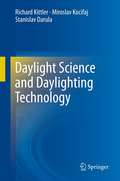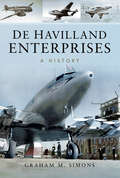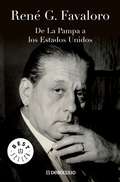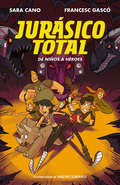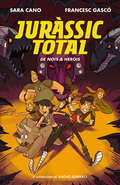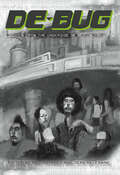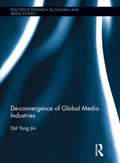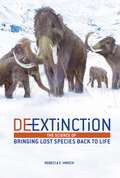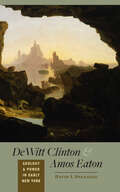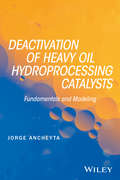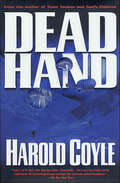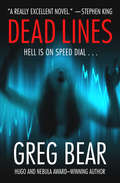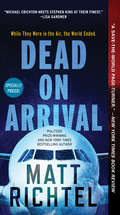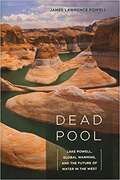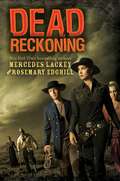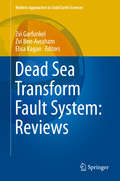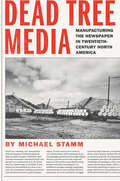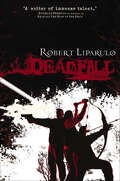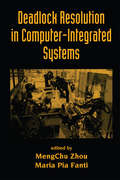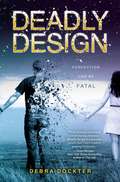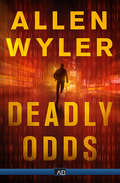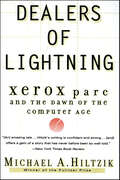- Table View
- List View
Daylight Science and Daylighting Technology
by Miroslav Kocifaj Richard Kittler Stanislav DarulaSunlight profoundly influences the Earth's atmosphere and biosphere. Nature fuels the evolution of all living things, their visual systems, and the manner in which they adapt, accommodate, and habituate. Sun luminance measurements serve as data to calculate typical changes in the daily, monthly, and annual variability characteristics of daylight. Climate-based sky luminance patterns are used as models in predicting daylighting calculation and computer programs applied in architecture and building design. Historically, daylight science and daylighting technology has prioritized photometric methods of measurements, calculation, and graphical tools aimed at predicting or evaluating the daylighting of architectural design alternatives. However, due to a heightened awareness of general health and well-being, sunlight exposure and freedom from visual discomfort while undertaking visual tasks are now equally prioritized. Therefore, in order to assure optimal environmental quality, daylighting technology must be based on sound science. Daylight Science and Daylighting Technology, by Richard Kittler, Miroslav Kocifaj, and Stanislav Darula, sketches the entire evolution of daylight science from atmospheric science through apt visual workplace psychophysics.
De Havilland Enterprises: A History
by Graham M. SimonsThis fully illustrated biography examines the life, achievements, and brilliant aircraft designs of one of the great pioneers of powered flight. From his groundbreaking designs during The Great War to the illustrious company that bore his name, Captain Sir Geoffrey de Havilland was one of the most important engineers in the history of aeronautics. Here, Graham Simons charts the course of de Havilland&’s life from his humble beginnings to the influences and milestones of his early years, his versatile warplanes, and the post-war formation of The De Havilland Aircraft Company Limited. Amongst the momentous machines that de Havilland helped develop were the Gipsy Moth and Tiger Moth, two iconic aircraft types destined to set a variety of aviation records while being piloted by de Havilland himself. His high-performance designs and monocoque wooden construction methods passed through the supremely elegant DH.91 Albatross into the Mosquito. Next came the high-performing Hornet fighter, which pioneered the use of metal-wood and metal-metal bonding techniques, eventually resulting in the world&’s first jet airliner, the fabulous Comet. Every one of De Havilland&’s products are recorded here in detail, along with the many designs that never left the drawing board and the products of De Havilland&’s companies in Australia and Canada.
De La Pampa a los Estados Unidos
by Rene FavaloroEl reconocido cirujano recuerda sus diez años de trabajo en equipo coneminentes personalidades de la medicina durante su estadía en laCleveland Clinic, que derivaron en las técnicas quirúrgicas para elimplante del by-pass de safena. La vida de los hombres oculta razones, decisiones y matices que solo losprotagonistas de esas vidas conocen a fondo. El testimonio del doctorFavaloro permite a los lectores adentrarse en una vida apasionante,tanto por las convicciones que la alientan como por los abundantesepisodios anecdóticos que ayudan a entenderla. La carrera profesionaldel médico argentino que viajó a Estados Unidos para perfeccionarse ylogró convertirse en un cirujano eminente está aquí junto a lasprofundas reflexiones de un hombre cuyos múltiples intereses provocancuriosidad, admiración y respeto.Nada de lo humano fue ajeno para quien eligió el oficio de mejorar lavida. El empeño vocacional a través del paso de los años, laespecialización y sus vínculos con la vida cotidiana, las obligaciones yel exilio, la libertad y el arraigo son temas que «De La Pampa a losEstados Unidos» aborda con deslumbrante lucidez.
De niños a héroes (Serie Jurásico Total #Volumen 3)
by Francesc Gascó Sara Cano FernándezLlega la tercera parte de «Jurásico Total». <P><P> ¡Prepárate para vivir mil aventuras en la era de los dinosaurios! <P><P>Carla, Lucas, Dani, Elena y Leo siguen en Pangea, en manos de Kahyla, la guardiana de los ahuluna. <P><P>Ella trata de entrenarlos para que sean también unos héroes dignos, pero... ¡es que ellos no son de ese mundo! Así que lo mejor será que vuelvan a casa y renuncien para siempre a sus amuletos. <P><P>Pero les queda mucho por descubrir en Pangea, y la aventura que vivirán intentando regresar será de las que hacen historia... ¿Lograrán convertirse en héroes y sobrevivir a este viaje?
De niños a héroes (Serie Jurásico Total #Volumen 3)
by Francesc Gascó Sara Cano FernándezLlega la tercera parte de «Jurásico Total». ¡Prepárate para vivir mil aventuras en la era de los dinosaurios! Carla, Lucas, Dani, Elena y Leo siguen en Pangea, en manos de Kahyla, la guardiana de los ahuluna. Ella trata de entrenarlos para que sean también unos héroes dignos, pero... ¡es que ellos no son de ese mundo! Así que lo mejor será que vuelvan a casa y renuncien para siempre a sus amuletos. Pero les queda mucho por descubrir en Pangea, y la aventura que vivirán intentando regresar será de las que hacen historia... ¿Lograrán convertirse en héroes y sobrevivir a este viaje?
De nois a herois (Sèrie Juràssic Total #Volumen 3)
by Francesc Gascó Sara Cano FernándezArriba la tercera part de «Juràssic Total». ¡Prepara't per viure mil aventures a l'era dels dinosaures! <P><P>La Carla, el Lucas, el Dani, l'Elena y el Leo encara són a Pangea, a mans de la Kahyla, la guardiana dels ahuluna. Ella intenta entrenar-los perquè siguin uns herois dignes com ella, però... és que ells no són d'aquest món! <P><P>El millor que poden fer és tornar a casa i renunciar per sempre als seus amulets. Perè els queden moltes coses per descobrir a Pangea, i l'aventura que viuran intentant tornar serà de les que fan història... <P><P>Aconseguiran convertir-se en herois i sobreviure a aquest viatge?
De-Bug: Voices from the Underside of Silicon Valley
by Raj Jayadev and Jean MelesaineStories of the dot-com boom—from everyone but the techies. “A raw look into the lives of residents bearing the brunt of gentrification.” —HuffPostNo shuttle buses here: De-Bug, a new collection of true stories from the social justice organization of the same name, shows a side of working in Silicon Valley that you won’t read about in the business section. As tech moguls land the cover of Forbes, the South Bay’s working class is making ends meet as metal scrappers, factory workers, club bouncers, hairstylists, rickshaw drivers, ice cream cart pushers. The stories in De-Bug are poignant, often very funny accounts of bootstrapping in the land of angel investors and thought leaders. A construction worker predicts which of his customers are about to strike it rich and which are on the edge of bankruptcy based on the states of their swimming pools. A “secondhand hustler” travels the garage sale-flea market circuit in search of treasures to resell online. A temp worker at a medical device manufacturer sells his blood, at the company’s request, to test the equipment. These storytellers are frank when discussing their own flaws, but are equally up-front about the rigged system in which they operate.Disruptive in the truest sense of the word, De-Bug offers valuable insight into California’s latest boomtown.“Silicon Valley’s less-noticed denizens show an unexpected knack for grace, wit, and survival.” —Kentaro Toyama, author of Geek Heresy“If you truly want to know Silicon Valley, in all of its complexity, then De-Bug is a must-read.” —Tomás Jiménez, associate professor of sociology, Stanford University
De-Convergence of Global Media Industries: De-convergence Of Global Media Industries (Routledge Research in Cultural and Media Studies #47)
by Dal Yong JinConvergence has become a buzzword, referring on the one hand to the integration between computers, television, and mobile devices or between print, broadcast, and online media and on the other hand, the ownership of multiple content or distribution channels in media and communications. Yet while convergence among communications companies has been the major trend in the neoliberal era, the splintering of companies, de-convergence, is now gaining momentum in the communications market. As the first comprehensive attempt to analyze the wave of de-convergence of the global media system in the context of globalization, this book makes sense of those transitions by looking at global trends and how global media firms have changed and developed their business paradigm from convergence to de-convergence. Jin traces the complex relationship between media industries, culture, and globalization by exploring it in a transitional yet contextually grounded framework, employing a political economic analysis integrating empirical data analysis.
De-Extinction: The Science of Bringing Lost Species Back to Life
by Rebecca E. HirschIn the twenty-first century, because of climate change and other human activities, many animal species have become extinct, and many others are at risk of extinction. Once they are gone, we cannot bring them back—or can we? With techniques such as cloning, scientists want to reverse extinction and return lost species to the wild. Some scientists want to create clones of recently extinct animals, while others want to make new hybrid animals. Many people are opposed to de-extinction. Some critics say that the work diverts attention from efforts to save species that are endangered. Others say that de-extinction amounts to scientists "playing God." Explore the pros and cons of de-extinction and the cutting-edge science that makes it possible.
DeWitt Clinton and Amos Eaton: Geology and Power in Early New York
by David I. SpanagelHow did geology and politics inform scientific ideas and contribute to New York's prominence in the early nineteenth century?David I. Spanagel explores the origins of American geology and the culture that promoted it in nineteenth-century New York. Focusing on Amos Eaton, the educator and amateur scientist who founded the Rensselaer School, and DeWitt Clinton, the masterful politician who led the movement for the Erie Canal, Spanagel shows how a cluster of assumptions about the peculiar landscape and entrepreneurial spirit of New York came to define the Empire State. In so doing, he sheds light on a particularly innovative and fruitful period of interplay among science, politics, art, and literature in American history.
Deactivation of Heavy Oil Hydroprocessing Catalysts: Fundamentals and Modeling
by Jorge AncheytaWritten by a scientist and researcher with more than 25 years of experience in the field, this serves as a complete guide to catalyst activity loss during the hydroprocessing of heavy oils.* Explores the physical and chemical properties of heavy oils and hydroprocessing catalysts; the mechanisms of catalyst deactivation; catalyst characterization by a variety of techniques and reaction conditions; laboratory and commercial information for model validations; and more* Demonstrates how to develop correlations and models for a variety of reaction scales with step-by-step descriptions and detailed experimental data * Contains important implications for increasing operational efficiencies within the petroleum industry* An essential reference for professionals and researchers working in the refining industry as well as students taking courses on chemical reaction engineering
Dead Hand
by Harold CoyleWhen an unforeseen asteroid strikes Siberia with the force of a thousand Hiroshimas, it triggers Dead Hand, the ultimate defense mechanism developed by the Soviets at the height of the Cold War.The missiles are pointing at the United States and its European allies, and ultra-nationalist General Likatchev is willing to use them as blackmail to topple the government in Moscow and return Russia to her status as world power. When Russia responds to world queries with cold silence, a NATO special operations unit is dropped into Siberia. Trapped in a region ravaged by freezing snow and the hellish aftermath of the asteroid impact, the NATO forces are racing against time to track down Likatchev and dismantle Dead Hand before a global holocaust is unleashed.At the Publisher's request, this title is being sold without Digital Rights Management Software (DRM) applied.
Dead Lines: Hell Is On Speed Dial ...
by Greg BearFrom a New York Times–bestselling author: A new kind of phone awakens the dead in this technological horror novel &“reminiscent of Koontz at his best&” (Booklist). Ever since his life was shattered by the kidnapping and murder of his young daughter, Peter Russell has become a ghost of a man. Once a successful director of adult films, he has been reduced to running questionable errands for an eccentric California millionaire. But everything changes when a Los Angeles start-up offers him the opportunity to create promotional videos for their revolutionary new technology, Trans. The product offers exceptionally powerful, crystal-clear mobile communication that can operate anywhere and everywhere—and Peter sets out to put it into every palm. But as he uses the device himself, he starts to see his murdered little girl . . . Soon, there are other voices—disembodied, confused, angry—emanating from a newly invaded dimension. Many are even malevolent . . . and hungry . . . and deadly. As the death toll of Trans-users skyrockets, Peter&’s life begins a new spiral downward. Now, he must race to make sense of the horror Trans has wrought before the gateway to Hell bursts wide open. With Dead Lines, author of the Eon series Greg Bear transforms the literary realm of Dean Koontz, Peter Straub, and Stephen King into something unique by ingeniously blending the speculative with the supernatural. You&’ll never look at your phone the same way again.
Dead On Arrival: A Novel
by Matt Richtel“MICHAEL CRICHTON meets STEPHEN KING at their finest … with the creepiest opening I’ve ever read.” — Lisa Gardner * “Joins the ranks of classic paranoid thrillers about human achievement run amok, with STEPHEN KING’s The Stand and Michael Crichton’s Terminal Man.” — Joseph Finder * “A heart-stopping thriller. … a must-read for MICHAEL CRICHTON fans.” — Dallas Morning News * “Similar in atmosphere and style to MICHAEL CRICHTON and STEPHEN KING. ... A race-against-the-clock thriller.” — BooklistFLIGHT 194 LANDED.SOMETHING LETHAL AWAITS OUTSIDE.THIS IS DEAD ON ARRIVAL.An airplane touches down at a desolate airport in a remote Colorado ski town. Shortly after landing, Dr. Lyle Martin, a world-class infectious disease specialist, is brusquely awakened to shocking news: Everyone not on the plane appears to be dead. The world has gone dark. While they were in the air, a lethal new kind of virus surfaced, threatening mankind's survival, and now Martin—one of the most sought-after virologists on the planet until his career took a precipitous slide—is at the center of the investigation.Moving at lightning pace from the snowbound Rockies to the secret campus of Google X, where unlimited budgets may be producing wonders beyond our capacity to control, Dead on Arrival is a brilliantly imaginative, intricately plotted thriller that draws on Matt Richtel's years of science and technology reporting for the New York Times, and establishes him as one of the premier thriller writers working today.
Dead Pool: Lake Powell, Global Warming, And The Future Of Water In The West
by James Lawrence PowellWhere will the water come from to sustain the great desert cities of Las Vegas, Los Angeles, and Phoenix? In a provocative exploration of the past, present, and future of water in the West, James Lawrence Powell begins at Lake Powell, the vast reservoir that has become an emblem of this story. At present, Lake Powell is less than half full. Bathtub rings ten stories tall encircle its blue water; boat ramps and marinas lie stranded and useless. To refill it would require surplus water―but there is no surplus: burgeoning populations and thirsty crops consume every drop of the Colorado River. Add to this picture the looming effects of global warming and drought, and the scenario becomes bleaker still. Dead Pool, featuring rarely seen historical photographs, explains why America built the dam that made Lake Powell and others like it and then allowed its citizens to become dependent on their benefits, which were always temporary. Writing for a wide audience, Powell shows us exactly why an urgent threat during the first half of the twenty-first century will come not from the rising of the seas but from the falling of the reservoirs.
Dead Reckoning
by Rosemary Edghill Mercedes LackeyJett is a girl disguised as a boy, living as a gambler in the old West as she searches for her long-lost brother. Honoria Gibbons is a smart, self-sufficient young woman who also happens to be a fabulous inventor. Both young women travel the prairie alone - until they are brought together by a zombie invasion! As Jett and Honoria investigate, they soon learn that these zombies aren't rising from the dead of their own accord ... but who would want an undead army? And why? This gunslinging, hair-raising, zombie western mashup is perfect for fans ofCowboys vs. Aliens and Pride & Prejudice & Zombies.
Dead Sea Transform Fault System: Reviews
by Zvi Garfunkel Zvi Ben-Avraham Elisa KaganThe Dead Sea transform is an active plate boundary connecting the Red Sea seafloor spreading system to the Arabian-Eurasian continental collision zone. Its geology and geophysics provide a natural laboratory for investigation of the surficial, crustal and mantle processes occurring along transtensional and transpressional transform fault domains on a lithospheric scale and related to continental breakup. There have been many detailed and disciplinary studies of the Dead Sea transform fault zone during the last 20 years and this book brings them together. This book is an updated comprehensive coverage of the knowledge, based on recent studies of the tectonics, structure, geophysics, volcanism, active tectonics, sedimentology and paleo and modern climate of the Dead Sea transform fault zone. It puts together all this new information and knowledge in a coherent fashion.
Dead Tree Media: Manufacturing the Newspaper in Twentieth-Century North America (Hagley Library Studies in Business, Technology, and Politics)
by Michael StammA deep and timely account of how American newspapers were produced and distributed on paper.Winner of the Best Book in Canadian Business History by the Canadian Business History AssociationPopular assessments of printed newspapers have become so grim that some have taken to calling them "dead tree media" as a way of invoking the medium’s imminent demise. There is a literal truth hidden in this dismissive expression: printed newspapers really are material goods made from trees. And, throughout the twentieth century, the overwhelming majority of trees cut down in the service of printing newspapers in the United States came from Canada. In Dead Tree Media, Michael Stamm reveals the international history of the commodity chains connecting Canadian trees and US readers. Drawing on newly available corporate documents and research in archives across North America, Stamm offers a sophisticated rethinking of the material history of the printed newspaper. Tracing its industrial production from the forest to the newsstand, he provides an account of the obscure and often hidden labor involved in this manufacturing process by showing how it was driven by not only publishers and journalists but also lumberjacks, paper mill workers, policymakers, chemists, and urban and regional planners. Stamm describes the 1911 shift in tariff policy that gave US publishers duty-free access to Canadian newsprint, providing a tremendous boost to Canadian paper manufacturers and a significant subsidy to American newspaper publishers. He also explains how Canada attracted massive American foreign investment in paper mills around the same time that US publishers were able to gain greater access to Canada’s vast spruce forests. Focusing particularly on the Chicago Tribune, Stamm provides a new history of the rise and fall of both the mass circulation printed newspaper and the particular kind of corporation in the newspaper business that had shaped many aspects of the cultural, political, and even physical landscape of North America. For those seeking to understand the travails of the contemporary newspaper business, Dead Tree Media is essential reading.
Deadfall: A Thriller (The John Hutchinson Novels)
by Robert LiparuloIt was supposed to be an escape from their daily lives.Deep in the isolated Northwest Territories, four friends are on the trip of a lifetime. Dropped by helicopter into the remote Canadian wilderness, Hutch, Terry, Phil, and David are looking to escape the events of a tumultuous year for two weeks of hunting, fishing, and camping.Now they just hope they escape alive.Armed only with a bow and arrow and the basics for survival, they've chosen a place far from civilization, a retreat from their turbulent lives. But they quickly discover that another group has targeted the remote region and the secluded hamlet of Fiddler Falls for a more menacing purpose: to field-test the ultimate weapon.Will they be able to beat the clock and save an innocent town from utter eradication?With more than a week before the helicopter rendezvous and no satellite phone, they must risk everything to help the townspeople who are being held hostage and terrorized. And with any luck, they might just survive themselves.Praise for Deadfall:&“What if Mad Max, Rambo, and the Wild Bunch showed up—all packing Star Wars-like weapons—in a small Canadian town? You&’d have the thrilling adventure novel Deadfall. Robert Liparulo reminds us that small-town life is still the scariest, and man&’s inhumanity to man is still The Most Dangerous Game.&” —Katherine Neville, New York Times bestselling author of The Eight&“Inventive, suspenseful, and highly entertaining. An engrossing and imaginative tale that sticks in your brain and makes you wonder about its real possibilities. Robert Liparulo is a storyteller, pure and simple.&” —Steve Berry, New York Times bestselling author of The Alexandria Link&“High-octane thrills are Robert Liparulo&’s specialty, and boy does he deliver in this ultimate tale of survival.&” —Tess Gerritsen, author of The Bone Garden&“Deadfall is a brilliantly crafted thriller with a terrifying premise and flawless execution. I loved it.&” —Michael Palmer, author of The Fifth VialBook 1 of the John Hutchinson novels (Book #2: Deadlock)Book length: over 100,000 words
Deadlock Resolution in Computer-Integrated Systems
by MengChu Zhou Maria Pia FantiComplex computer-integrated systems offer enormous benefits across a wide array of applications, including automated production, transportation, concurrent software, and computer operating systems, computer networks, distributed database systems, and many other automated systems. Yet, as these systems become more complex, automated, distributed, and computing-intensive, the opportunity for deadlock issues rises exponentially. Deadlock modeling, detection, avoidance, and recovery are critical to improving system performance.Deadlock Resolution in Computer-Integrated Systems is the first text to summarize and comprehensively treat this issue in a systematic manner. Consisting of contributions from prominent researchers in the field, this book addresses deadlock-free models and scheduling, detection and recovery methods, the formulation of dynamic control policies, and comparison and industrial benchmark studies that evaluate various approaches. The editors lay the foundation for exploring deadlock issues with a typical example of an automated manufacturing process, illustrating three primary modeling methods (digraphs, Petri nets, and automata) and comparing their respective advantages and disadvantages.Providing all of the important models and resolution approaches, this book is the complete guide for electrical and control engineers and manufacturing, intelligent, and network systems designers to prevent and manage deadlock issues in their systems.
Deadly Design
by Debra DockterThe emotional power of If I Stay meets the survival story of Maze Runner Genetically engineered identical twins Kyle and Connor McAdams were born two years apart. Their parents figured it was safer that way, to increase their odds of survival. Connor was born first, paving an impossibly perfect path for Kyle to follow. He was the best at everything--valedictorian, star quarterback etc. Kyle never thought he'd be able to live up, so he didn't even try. But when Connor, 18, suddenly drops dead of a heart attack, and Kyle learns of other genetically modified kids who've also died on their eighteenth birthdays, he's suddenly motivated--to save his own life. Like Connor and all the rest, Kyle was conceived at the Genesis Innovations Laboratory, where the mysterious Dr. Mueller conducted experiments on them. The clock's ticking as Kyle searches for answers: who was Dr. Mueller really, and what did he do to cause their hearts to stop at eighteen? He must unravel the clues quickly, before, he too, becomes another perfect, blue-eyed corpse.
Deadly Odds
by Allen WylerIn this “first rate thriller,” a young hacker goes to Vegas to get lucky—and instead gets caught up in a terrorist plot with life and death stakes (Phillip Margolin). At twenty-three years old, Seattle-based computer genius Arnold Gold devised a program capable of predicting the outcome of almost any event. While his success in sports betting hasn’t improved his odds with women, he’s in Las Vegas to get lucky in more ways than one. But when the wrong people learn of his valuable talents, Gold finds himself thrust into a deadly game of international intrigue. Now the FBI, local police, and dangerous radicals are on his tail, and his only chance to save himself is to find the location of a massively devastating bomb hidden somewhere in Sin City . . . “With Allen Wyler, you get thrills and a dash of humor combined in a high-tech plot written by a guy who knows what he’s talking about.” —Mike Lawson, award-winning author of the Joe DeMarco series
Dealers of Lightning: Xerox PARC and the Dawn of the Computer Age
by Michael A. HiltzikThe Pulitzer Prize-winner’s classic account of the legendary research lab that gave rise to the Digital Age.In the 1970s and ‘80s, Xerox Corporation brought together a brain-trust of engineering geniuses dubbed PARC (Palo Alto Research Center). This brilliant group created several monumental innovations that triggered a technological revolution, including the first personal computer, the laser printer, and the graphical interface (one of the main precursors of the Internet). And when these breakthroughs were rejected by the corporation, these determined inventors turned their ideas into empires that changed the world.Based on extensive interviews with the scientists, engineers, administrators, and executives who lived the story, Dealers of Lightning details PARC’s rise from humble beginnings to a hothouse for ideas. It also shows why Xerox was never able to grasp the cutting-edge innovations PARC delivered. Michael A. Hiltzik offers an unprecedented look at the ideas, the inventions, and the individuals that propelled Xerox PARC to the frontier of techno-history—and the corporate machinations that almost prevented it from achieving greatness.
Dealing with Aging Process Facilities and Infrastructure
by CcpsExamines the concept of aging process facilities and infrastructure in high hazard industries and highlights options for dealing with the problem while addressing safety issues This book explores the many ways in which process facilities, equipment, and infrastructure might deteriorate upon continuous exposure to operating and climatic conditions. It covers the functional and physical failure modes for various categories of equipment and discusses the many warning signs of deterioration. Dealing with Aging Process Facilities and Infrastructure also explains how to deal with equipment that may not be safe to operate. The book describes a risk-based strategy in which plant leaders and supervisors can make more informed decisions on aging situations and then communicate them to upper management effectively. Additionally, it discusses the dismantling and safe removal of facilities that are approaching their intended lifecycle or have passed it altogether. Filled with numerous case studies featuring photographs to illustrate the positive and negative experiences of others who have dealt with aging facilities, Dealing with Aging Process Facilities and Infrastructure covers the causes of equipment failures due to aging and their consequences; plant management commitment and responsibility; inspection and maintenance practices for managing life cycle; specific aging asset integrity management practices; and more. Describes symptoms and causal mechanisms of aging in various categories of process equipment Presents key considerations for making informed risk-based decisions regarding the repair or replacement of aging process facilities and infrastructure Discusses practices for managing process facility and infrastructure life cycle Includes examples and case histories of failures related to aging Dealing with Aging Process Facilities and Infrastructure is an important book for industrial practitioners who are often faced with the challenge of managing process facilities and infrastructure as they approach the end of their useful lifecycle.
Dealing with Contaminated Sites
by Frank A. SwartjesThis standard work on contaminated site management covers the whole chain of steps involved in dealing with contaminated sites, from site investigation to remediation. An important focus throughout the book is on Risk Assessment. In addition, the book includes chapters on characterisation of natural and urban soils, bioavailability, natural attenuation, policy and stakeholder viewpoints and Brownfields. Typically, the book includes in-depth theories on soil contamination, along with offering possibilities for practical applications. More than sixty of the world's top experts from Europe, the USA, Australia and Canada have contributed to this book. The twenty-five chapters in this book offer relevant information for experienced scientists, students, consultants and regulators, as well as for 'new players' in contaminated site management
